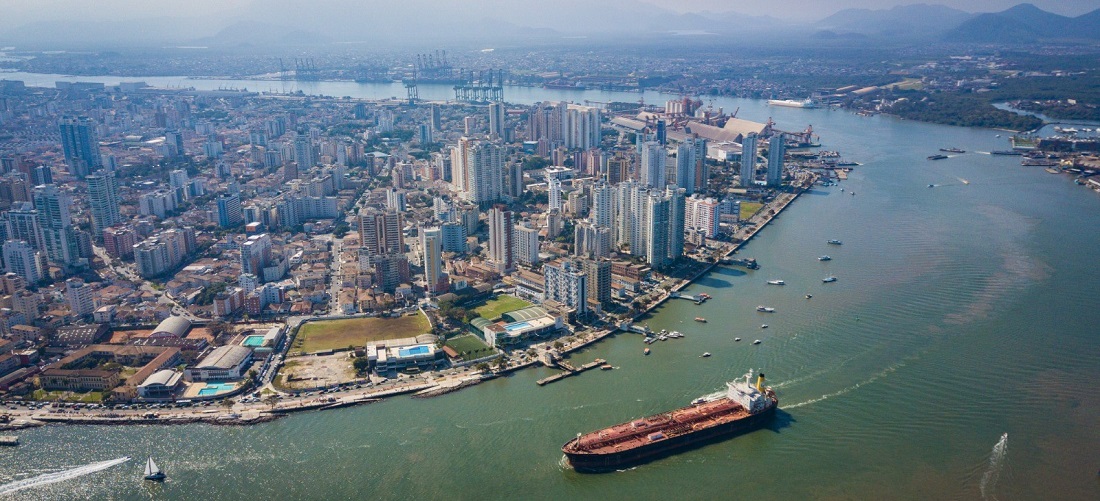
Powershoring emerges as sustainable development option for Port of Santos
Sep, 12, 2023 Posted by Gabriel MalheirosWeek 202337
Latin America, Brazil, and especially the Port of Santos are on the powershoring radar. This term refers to the attraction of industrial plants powered by clean energy, i.e., energy derived from renewable sources such as hydropower, wind, solar, and biomass, in countries where they are abundant.
“Powershoring represents a significant opportunity for Brazil and is a strategy that can be decisive for energy-intensive industries like steel, glass, fertilizers, cement, pulp and paper, and ceramics,” says Davi Bomtempo, Executive Manager of Environment and Sustainability at the National Confederation of Industry (CNI).
He adds, “These and other sectors, which have been under pressure due to energy costs and the urgency to decarbonize production, can find in Brazil a secure destination for establishing their factories.”
Companies from North America, Europe, Japan, and China, in particular, are interested in this concept. Previously, the priority was to have factories in regions with cost-effective labor. Now, the need to decarbonize the economy to combat global warming makes one of the main attractions for industry the abundant and secure supply of renewable energy.
Several factors favor Brazil in this segment, such as its strategic location, distance from regions with complex geopolitical issues and extreme weather events, a wide variety of mineral and agricultural products for industrial use, and, of course, the already significant presence of multinational companies in various sectors.
“This is a production strategy for export. We are talking about production zones close to ports. This is ideal: port zones with production back areas supplied with green energy,” says Jorge Arbache, Vice President of the Private Sector at the Development Bank of Latin America and the Caribbean (CAF).
“And this is what happens, for example, at the Port of Santos. A significant portion, if not all, of the energy in the Santos complex comes from the grid. The Port of Santos can join this global investment route in Brazil, receiving large investments as has already been happening. We have documented this in the region and in Brazil. It is highly likely that this will accelerate in the coming years,” adds the development bank’s vice president.
The chart that follows gives further details on exports and imports in containers at the Port of Santos between January 2019 and July 2023. The data used below was gathered by Datamar using the DataLiner maritime intelligence tool.
Exports & imports at Port of Santos | Jan 2019 – July 2023 | TEU
Source: DataLiner (click here to request a demo)
CAF recently announced that it is in negotiations to provide up to $600 million as financing for credit lines for investments in green energy industrial plants to the Brazilian Development Bank (BNDES) and the Bank of the Northeast (BNB). According to Arbache, $500 million is expected to be allocated to BNDES and between $50 million and $100 million to BNB. It was CAF that coined the term powershoring.
In addition to the Port of Santos, Arbache highlighted that the complexes of Pecém (CE), Aratu (BA), Suape (PE), and Rio Grande (RS) also combine the conditions of multimodal ports for manufacturing with industrial zones supplied with green energy.
Figures
To get an idea of how crucial Brazil is in this regard, in 2020, according to the International Energy Agency (IEA), 82% of the world’s energy matrix and 71.4% of its electrical matrix came from non-renewable sources. For example, in the United States, these indicators represent 92% and 61%, respectively; in China, 90% and 67%; in the United Kingdom, 86% and 58%; and in Brazil, 50.3% and 15.4%.
Data from the National Energy Balance shows that renewable sources had a 47.4% share in the Brazilian matrix, a significantly higher percentage than the world average of 14.1%. Brazil, the second-largest producer of biofuels behind the United States, is also developing innovative technologies and business models in this area.
Examples include hybrid cars powered by ethanol or electricity. Another initiative is fuel cells that convert ethanol into hydrogen at the gas station or in the vehicle itself to generate electricity. There are also studies on producing diesel, aviation kerosene, and green hydrogen from soybean, macaw palm, and oil palm oils.
To enjoy these benefits, the Port of Santos and the surrounding cities must prepare, notes Arbache. “There is a growing interest, not out of love for the region, but out of love for the competitiveness of companies themselves that need to seek alternatives. Santos must prepare by implementing not only advanced logistics and simplified procedures but also human capital, infrastructure, regulation, and value chain-related issues.”
Everything, emphasizes the CAF representative, boils down to understanding what needs to be done. “Those who understand better and prepare are likely to be in an increasingly favorable position to attract these investments. There is, of course, competition among Latin American countries, as well as within Brazil. And increasingly,” he adds.
Arbache reminds us that the Santos port complex needs a strategic outlook and a strategy for receiving these investments.
“It cannot be a retail-type, isolated thing. There must be a flight plan to offer these investors increasingly seeking alternatives. They are coming to Latin America to talk, listen, and find out what facilities are available for them to land their industrial plants. And the Port must be part of this agenda, with a structured, integrated, and holistic vision. It may seem simple, but in reality, it’s quite complex. And that’s the direction it needs to take.”
Source: A Tribuna
To read the original news report, see: https://www.atribuna.com.br/noticias/portomar/powershoring-e-opcao-sustentavel-de-desenvolvimento-para-o-porto-de-santos
-
Shipping
Apr, 03, 2023
0
Boxship demolition slows to crawl
-
Trade Regulations
Aug, 09, 2019
0
EU-Mercosur trade deal opens market for auto parts exports
-
Shipping
Sep, 25, 2019
0
CMA CGM launches world’s largest LNG-powered container ship
-
Shipping
Mar, 13, 2023
0
ZIM increases annual revenues amid slight container decline


